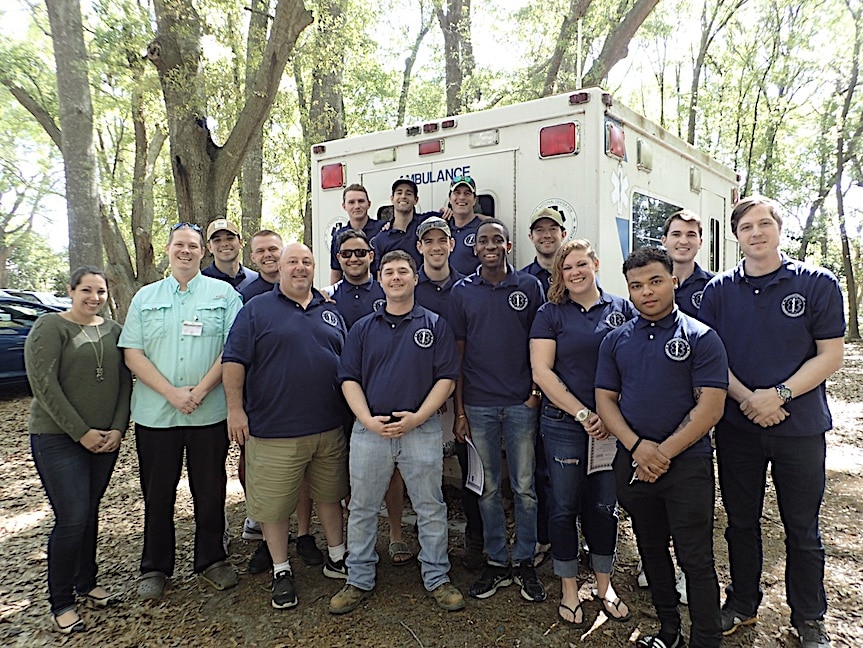Depending on where you live, you may see them every day or just when there’s a fire, police, or medical emergency where you are. Regardless of the frequency with which you see them, you may be wondering — what exactly does an EMT (Emergency Medical Technician) do?
EMTs are not just “ambulance drivers,” although that’s certainly a critical part of their occupation. An Emergency Medical Technician is a trained and certified medical provider who has demonstrated competency in basic pre-hospital medical care.
For EMTs and patients, an ambulance is more than transportation to the hospital. It’s a mobile mini-medical center squeezed into the back of a moving vehicle where a skilled team of pre-hospital healthcare providers perform a variety of life-saving medical interventions that save lives every day in every community.
What an EMT Must Learn
While nearly anyone can attempt to become an EMT, in order to qualify to take and pass the National Registry of Emergency Medical Technicians certification exam, candidates must first complete an approved EMS education program. In that program, EMT candidates’ study and learn a lot of things, including:
- The fundamentals of how to perform a full patient assessment, recognize life threatening problems, and intervene to keep people alive.
- How to stop bleeding, perform CPR, and assist breathing.
- First Aid and to how to respond to a cardiac arrest.
- Also, how to recognize a heart attack or stroke and what to do to give the patient the best chance of survival.
- Basic anatomy and physiology, what causes common diseases like diabetes and asthma, and how to treat emergencies associated with them.
- Depending on the state, EMTs are authorized to administer 10 to 20 different medications, including epinephrine for an anaphylactic reaction, narcan for an overdose, or albuterol for an asthma attack. That means they must learn how to assess and administer for each of those conditions.
No Two EMT Calls are Alike
EMTs are expected to operate independently and make decisions without direct supervision from a physician. They respond to every imaginable environment and situation. And each encounter has its own unique set of challenges to overcome. EMTs learn to think on their feet and adapt. In addition:
- EMTs may work in a variety of settings, and almost always as part of a team.
- Many EMTs work on a 911 emergency response ambulance. Sometimes that is with another EMT, or it may be with a higher-level emergency healthcare provider such as a paramedic.
- Shifts most commonly are 12 or 24 hours. There are both paid and volunteer services. Crews respond to 911 dispatched calls.
- Non-emergent medical transport is also common. Two EMTs work together on an ambulance to transport people to/from nursing homes, doctor’s appointments or hospitals.
Where Else do EMTs Work?
Many fire departments require that all of their firefighters also be EMTs. They respond to medical emergencies and provide treatment on scene to assist the ambulance crews.
Emergency Departments and doctor’s offices often employ EMTs in a similar role to a certified nursing assistant (CNA) or medical technician. They obtain vitals and assist with direct patient care within the facility.
Camps, amusement parks, movie studios, and a variety of other private entities are always looking for qualified EMTs to provide onsite medical care for patrons and employees.
A Typical Day in the Life of an EMTs
What services you perform as an EMT each day depends greatly on where you work. Some positions are so busy you’ll spend almost the entire shift on the road, caring for patients. Others are a little slower, enabling you to spend some down time hanging out at the station. That’s a great time to hit up the veterans for how they do things and what they’ve learned over the years.
If you succeed, you’ll be part of an amazing profession and an important asset to one of the healthcare teams in your community. And you’ll meet some incredible people — not only within the health provider community, but among the patients you assist. It’s not a career for those who are averse to adventure.
Learn more about becoming an EMT by visiting the 21-day intensive EMT training page on our website.
TALK TO US
Have any further questions about our courses, what you’ll learn, or what else to expect? Contact us, we’re here to help!

Leave a comment